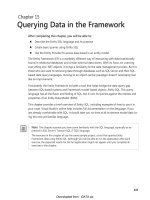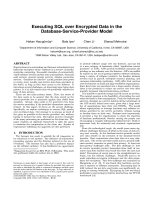Data preparation in the big data era
Bạn đang xem bản rút gọn của tài liệu. Xem và tải ngay bản đầy đủ của tài liệu tại đây (2.63 MB, 30 trang )
Data Preparation in the Big Data
Era
Best Practices for Data Integration
Federico Castanedo
Data Preparation in the Big Data Era
by Federico Castanedo
Copyright © 2015 O’Reilly Media, Inc. All rights reserved.
Printed in the United States of America.
Published by O’Reilly Media, Inc., 1005 Gravenstein Highway North,
Sebastopol, CA 95472.
O’Reilly books may be purchased for educational, business, or sales
promotional use. Online editions are also available for most titles
(). For more information, contact our
corporate/institutional sales department: 800-998-9938 or
Editor: Shannon Cutt
Production Editor: Dan Fauxsmith
Interior Designer: David Futato
Cover Designer: Randy Comer
Illustrator: Rebecca Demarest
August 2015: First Edition
Revision History for the First Edition
2015-08-27: First Release
2015-11-04: Second Release
The O’Reilly logo is a registered trademark of O’Reilly Media, Inc. Data
Preparation in the Big Data Era, the cover image, and related trade dress are
trademarks of O’Reilly Media, Inc.
While the publisher and the authors have used good faith efforts to ensure
that the information and instructions contained in this work are accurate, the
publisher and the authors disclaim all responsibility for errors or omissions,
including without limitation responsibility for damages resulting from the use
of or reliance on this work. Use of the information and instructions contained
in this work is at your own risk. If any code samples or other technology this
work contains or describes is subject to open source licenses or the
intellectual property rights of others, it is your responsibility to ensure that
your use thereof complies with such licenses and/or rights.
978-1-491-93895-9
[LSI]
Chapter 1. Data Preparation in
the Era of Big Data
Introduction
Preparing and cleaning data for any kind of analysis is notoriously costly,
time consuming, and prone to error, with conventional estimates holding that
80% of the total time spent on analysis is spent on data preparation.1
Accelerating investment in big data analytics — $44 billion total in 2014
alone, according to Gartner — elevates the stakes for successfully preparing
data from many sources for use in data analysis.
Substantial ROI gains can be realized by modernizing the techniques and
tools enterprises employ in cleaning, combining, and transforming data. This
report introduces the business benefits of big data and analyzes the issues that
organizations face today with traditional data preparation and integration. It
also introduces the need for a new approach that scales, known as data
curation, and discusses how to deliver the results.
This report will cover the following key topics:
Starting with the business question
Understanding your data
Selecting the data to use
Analyzing your current data strategy
Assessing alternative ETL and data curation products
Delivering the results
Starting with the Business Question
What are you aiming and analyzing for, exactly?
We are currently living in the big data era, with huge business opportunities
and challenges for every industry. Data is growing at an exponential rate
worldwide: in 2016, global Internet traffic will reach 90 exabytes per month,
according to a recent Cisco report.2
The ability to manage and analyze an unprecedented amount of data will be
the key to success for every industry. Data-driven companies like Google,
Amazon, Facebook, and LinkedIn have demonstrated a superior position
against their competitors. It is well-known that Google based most of their
success on their available data, and as they mention in a paper published in
20093: “We don’t have better algorithms. We just have more data”. It has
also been reported that data-driven companies can deliver profit gains that are
on average 6% higher than their competitors.4
To exploit the benefits of a big data strategy, a key question is how to
translate data into useful knowledge. To meet this challenge, a company
needs to have a clear picture of the strategic knowledge assets, such as their
area of expertise, core competencies, and intellectual property. Having a clear
picture of the business model and the relationships with distributors,
suppliers, and customers is extremely useful in order to design a tactical and
strategic decision-making process. The true potential value of big data is only
gained when placed in a business context, where data analysis drives better
decisions — otherwise it’s just data.
Which Questions to Answer
In any big data strategy, technology should be a facilitator, not the goal, and
should help answer business questions such as: Are we making money with
these promotions? Can we stop fraud by better using this novel approach?
Can we recommend similar products to our customers? Can we improve our
sales if we wish our customers a happy birthday? What does data mean in
terms of business? And so on.
Critical thinking must be used to determine what business problem you want
to solve or which questions you wish to answer. As an example, you should
have clear and precise answers for the following general questions: Why are
we doing this? What are we trying to achieve? How are we going to measure
the success or failure of this project?
Articulate Your Goals
There is a false belief that only big companies can obtain benefits from
developing a big data strategy. Since data is being generated so fast, and at an
exponential rate, any small- or medium-sized enterprise will gain a
competitive advantage by basing their business decisions on data-driven
products.
However, it is extremely important to articulate clear goals and business
objectives from the very beginning. Implementing a well-defined data
strategy allows companies to achieve several benefits, such as having a better
understanding of their customer base and business dynamics. This investment
produces rewarding returns in terms of customer satisfaction, increases in
revenues, and cost reduction. Each data strategy should be aligned with
tactical and strategic objectives. For example, in the short term, the goal may
be to increase the user base and in the mid/long term to increase revenues. In
addition to setting goals, it’s also important to optimize the appropriate key
performance indicator (KPI) at each stage of the strategy. In any big data
strategy, starting the implementation by defining the business problem you
want to solve is what matters.
Gain Insight
The data you analyze should support business operations and help generate
decisions in the company. Any results should be integrated seamlessly with
the existing business workflows, and will only be valuable if managers and
frontline employees understand and use those results accordingly.
Here are four steps for any company to gain specific insights into their
business problems:
1. Start with a business question. For example, if we change the size of
our product, will this result in an increase in sales?
2. Come up with a hypothesis. Following our example above, you might
hypothesize: a smaller size may increase revenues.
3. Perform an exhaustive analysis of the impact of your decision, before
you make it. Gather data using various methods, including controlled
and double-blind experiments, and A/B testing.
4. Draw conclusions to your business question, based on the outcome of
your experiments and analysis; use these conclusions to aid in your
business decisions.
Data silos
One challenge that some companies may face in implementing a big data
strategy is the existence of data silos among different areas of the company.
When data silos are present, your business’s data is distributed among the
different silos, without communication and interfaces between them.
As part of your big data strategy, you should plan to integrate data projects
into a coherent and unified view and, even more importantly, avoid (as much
as possible) moving data from one place to another.
In a big data project, input data sources can come from different domains, not
only from traditional transactions and social network data, and it is necessary
to combine or fuse them. In order to successfully combine your data, it’s
important to first understand it, and your goals.
Data lakes
Until you have a solid grasp on the business purpose of your data, you can
store it in a data lake. A data lake is a storage repository that holds raw input
data, where it can be kept until your company’s goals are clear. An important
drawback of data lakes is the generation of duplicate information, and the
necessity of dealing with the data variety problem in order to perform correct
data integration. Data variety, together with velocity and volume, is one of
the “three V’s” of big data characteristics. Data variety refers to the number
of distinct types of data sources. Since the same information can be stored
with different unique identifiers in each data source, it becomes extremely
difficult to identify similar data.
Understanding Your Data
While “big data” has become a buzzword, the term “data” is actually very
broad and general, so it’s useful to employ more specific terms, like: raw
data, technically-correct data, consistent data, tidy data, aggregated or
compressed data, and formatted data — all terms we’ll define in this section.
Raw data refers to the data as it comes in. For example, if files are the source
of your data, you may find the files have inconsistent elements — they may
lack headers, contain wrong data types (e.g., numeric values stored as
strings), missed values, wrong category labels, unknown character encoding,
etc. Without doing some sort of data preprocessing, it is impossible to use
this type of data directly in a data analysis environment or language.
When errors in raw data are fixed, the data is considered to be technically
correct. Data that is technically correct generally means that each variable is
stored using the same data type, which adequately represents the real-world
domain. But, that does not mean that all of the values are error-free or
complete. The next level in the data preparation pipeline is having consistent
data, where errors are fixed, and unknown values imputed.
When data is consistent and ready for analysis, it is usually called tidy data.
Tidy datasets are easy to manipulate and understand; they have a specific
structure where each variable is saved in its own column, each observation is
saved in its own row, and each type of observational unit forms a table.5
It is also common to aggregate or compress tidy data for use in data analysis.
This means that the amount of historical data is reduced significantly. Finally,
the results obtained from the analysis are provided in formatted data.
It is a good practice to store the input data at each different phase: (1) raw, (2)
technically correct, (3) consistent/tidy datasets, (4) aggregated, and (5)
formatted. That way, it will be easy to modify the data process in each phase,
as needed, and minimize the impact on the other phases.
It is also important to know the source of the data at each phase, and which
department owns the data or has responsibility for its management.
Selecting the Data to Use
Most machine learning and data analysis techniques assume that data is in an
appropriate state for doing the analysis. However this situation is very rare —
raw data usually comes in with errors, such as incorrect labels and
inconsistent formatting, that make it necessary to prepare the data. Data
preparation should be considered an automated phase that can be executed in
a reproducible manner.
If your input data is in file format, it is important to consider character
encoding issues and ensure that all of the input files have the same encoding,
and that it’s legible by the processing machine. Character encoding defines
how to translate each character of a given alphabet into a sequence of
computer bytes. Character encoding is set by default in the operating system
and is defined in the locale settings. Common encoding formats, for example,
are UTF-8 and latin1.
Data Preparation Methods
Depending on the type of your input data, you can use different methods to
prepare it for analysis.
For date-time data, it is common to use POSIX formats and store the value as
the number of seconds that have passed since January 1st, 1970 00:00:00.
This format facilitates computations by directly subtracting or adding the
values. Converting input dates into a standard format is not always trivial,
because data can be described in many different ways. For instance, July 15
of 2015, 2015/15/07, or 15/07/2015 may refer to the same date.
In the case of categorical variables, the work of classifying dirty input text
into categorical variables is known as coding. String data are one of the most
difficult data types in which to detect errors or inconsistencies in the values.
Most of the times, this data comes from human input, which easily introduces
inconsistencies. Techniques to deal with string inconsistencies are known as
string normalization or approximate string matching.
On the one hand, string normalization techniques transform a variety of
strings to a common and smaller set of string values. These techniques
involve two phases: (1) finding a pattern in the string, usually by means of
regular expressions, and (2) replacing one pattern with another. As an
example, consider functions to remove extra white spaces in strings.
On the other hand, approximate string matching techniques are based on a
distance metric between strings that measures how different two strings are.
From a mathematical point of view, string metrics often do not follow the
demands required from a distance function. As an example, string metrics
with zero distance does not necessarily mean that strings are the same, like in
the q-gram distance. One of the most common distances is the generalized
Levenshtein distance, which gives the minimal number of insertions,
deletions, and substitutions needed to transform one string into another. Other
distance functions include Demareu-Levenshtein, the longest common
substring, the q-gram distance, the cosine distance, the jaccard distance, and
the Jaro-Winkler distance. For more details about approximate string
matching, please refer to Boytsov6 and Navarro7.
Analyzing Your Current Data Strategy
When data is ready for statistical analysis, it is known as consistent data. To
achieve consistent data, missing values, special values, errors, and outliers
must be removed, corrected, or imputed. Keep in mind that data-cleaning
actions, like imputation or outlier handling, most likely affect the results of
the data analysis, so these efforts should be handled correctly. Ideally, you
can solve errors by using the expertise of domain experts, who have realworld knowledge about the data and its context.
Data consistency can be divided into three types:
1. In-record consistency
2. Cross-record consistency
3. Cross-data-set consistency
In-record consistency means that no contradictory information is stored in a
single record; cross-record consistency means that statistical summaries of
different variables do not conflict among them, and cross-data-set
consistency indicates that the dataset being analyzed is consistent with other
datasets of the same domain.
Missing Values
Missing values (known as NA) are one of the most basic inconsistencies.
Some data analysis methods can deal with NAs, while others may fail when
the data has missing input values, or may confuse a missing value with a
default category.8
NAs are commonly confused with an unknown category; however, these are
two different ideas. An NA value states that the information is not available
in the dataset, whereas an unknown value indicates that the information is in
the dataset but it is unknown. If the records may have an unknown category,
this should not be confused with the NA values. A simple approach to deal
with NAs is to ignore the records that contain them. When the ratio of NAs
versus all of the data is high, it is better to use imputation techniques.
Imputation Techniques
Imputation techniques correct NAs by estimating values based on other
information. The most basic imputation method is to determine the mean of
the observed values, or any other measure of centrality. Another method is
known as ratio imputation, where the estimate Xi is given by an average ratio
between x and a covariate y: Xi = Ryi. This is commonly computed as the sum
of observed x values, divided by the sum of corresponding y values. It has the
property that x = 0 when y = 0, which is in general not guaranteed in linear
regression.
Generalized linear regression models can also be used as an imputation
method. In this case, missing values are estimated by using a linear
regression from known variables.
Hot deck imputation is a technique that replaces NAs by copying values from
similar records in the dataset. It can be applied to numerical or categorical
records. A critical decision in using hot deck imputation is how to select
similar records.
Here are a few methods for selecting similar records:
Randomly select one value from the known ones.
Sorted selection, where the missing value is selected based on the closest
value of one or more known auxiliary variables.
Nearest-neighbor imputation with a specific distance function that
computes a measure of similarity between records. A missing value is
imputed by finding the nearest or k-nearest records (K-NN). In the case of
K-NN, if the missing value is categorical, the level with the higher
frequency is chosen, and if it is numerical, the mean would be the value
usually taken.
Inconsistencies and outliers
There may be also some obvious inconsistencies in the data, like negative age
values. These kind of inconsistencies are easy to detect and fix by using a set
of user-defined rules or constraints. However, as the number of variables
increases (i.e., high dimensional spaces), the number of rules may increase
rapidly, and it may be beneficial to have an automated mechanism to generate
them. Furthermore, multivariate rules may be interconnected by common
variables, and deciding which variable causes an inconsistency may be
difficult.
Sometimes rules can be interconnected, and it is necessary to make a decision
about which interconnected inconsistencies should be solved. The principle
of Fellegi and Holt9 minimizes the number of fields being altered — this
approach makes sense if the errors occur relatively few times and randomly
across variables. Other common inconsistencies for numeric variables are
those having special values, such as infinite and Not a Number (NaN). Note:
these “not-real” numbers should also be removed before data analysis.
Outliers also require special attention. In general, outliers are very
informative because they can indicate a special situation or an error. For a
good overview about outliers, check-out the work of Barnett and Lewis10 and
Hawkins11.
Whether or not outliers should remain in your data depends on the goal of
your analysis. For instance, if you are looking for patterns in the data (like
fraud-detection systems), outliers should be included and identified
accordingly. In other cases, if we are providing some historical analysis, they
may be removed to avoid introducing noise. In unimodal and symmetrically
distributed data, Tukey’s box-and-whisker method is the common technique
to detect and visualize outliers. In Tukey’s method, outliers are defined as
those values larger than each whisker. Each whisker is defined by adding 1.5
times the interquartile range to the third quartile and rounding to the nearest
lower observation. This method fails when the distribution of data is skewed,
as in exponential or log-normal distributions. One workaround is to transform
the data using a logarithm or square root transformation, or use a method that
takes the skew into consideration, such as the Hiridoglou and Berthelot
method for positive observations.12
All of the above methods fix inconsistent observations by modifying invalid
values in a record, using information from valid values. Sometimes the cause
of errors or inconsistencies in the data can be solved automatically with
enough certainty, but there are several cases where it wouldn’t be so easy and
more advanced methods are required.
Assessing Alternative ETL and Data Curation
Products
Extract-Transform-Load (ETL) was the name coined for the first-generation
data integration systems. ETL products are used to combine data into a
common data warehouse. They have evolved into data curation products by
introducing data cleaning phases as well.
Data curation involves data cleaning, schema definition/mapping, and entity
matching. As mentioned earlier, the process of data cleaning transforms raw
data into consistent data that can then be analyzed. Schema
definition/mapping is the process of making connections among data
attributes and features. Entity matching is the task of finding different records
in the data sources that refer to the same entity. Entity matching is essential
when data from multiple sources are integrated, because it allows you to
remove duplicate records.
Manual data curation is not an easy or feasible task, since companies usually
have hundreds of databases and many thousands of tables. Furthermore, the
increasing amount of data being stored introduces scalability problems for
doing data curation. Problems also arise when companies acquire other
companies, and the same information is stored using different schemas.
Therefore, a key problem is often how to deal with the data cleaning and
curation problem, cost effectively and at large scale.
Crowd-Sourcing Data Curation
Users or domain experts have been involved in the data curation problem in
different scenarios.
In early 2008, Facebook launched a tool called Translations — allowing
social network users to translate their site into different languages. In doing
so, Facebook leveraged their users as a type of human crowdsourcing project
to do the hard work of translating the site into several languages, and filed a
patent named “Hybrid, offline/online speech translation system” describing
and protecting their strategy. Twitter also followed a similar approach and
relied on volunteers to translate their site.
At LinkedIn, they followed a strategy named “Data Jujitsu,” to solve data
cleaning/curation problems, among others. For instance, to match the
employer names of its users — LinkedIn provided users with some features,
like type-ahead completion, and asking for the company’s ticker symbol or
website. This was opposed to leaving a blank text box for users to type in
their employer’s name, which would generate several varying responses for
the same company (e.g., I.B.M or IBM). This was a clever and easy approach
to solve a specific data curation problem.
The Crowder research project from Berkeley AMPlab is a hybrid humanmachine approach to solve the entity resolution problem. They developed fast
algorithms to detect similar entities and exploit transitivity to reduce the
crowd cost required to examine similar candidate pairs.
The SampleClean research project is an extension of the Crowder project,
created to deal with large databases. Instead of cleaning the full data sources,
it only cleans a sample of the full dataset. Therefore, it provides more
accurate results than the original dirty data, without the overhead of cleaning
all of the data.
For more details on projects using crowdsourced data processing, check out
/>Data curation will require more efforts in the future because there is a
growing interest in integrating structured business data with semi-structured
and unstructured data from web pages, time series, etc. Therefore, the data
variety characteristic of big data will introduce many new challenges.
One Commercial Solution
Tamr, a commercial product focused on the data curation problem at scale,
attempts to solve the variety issue of big data. Tamr’s input data sources can
reside in HDFS, CSV files, or relational databases. After reading the input
sources, Tamr can generate the schemas of the sources and curate the data.
Schema mapping in Tamr takes advantage of metadata features such as
attribute name, data type, and constraints, as well as statistical profiles of
values or value length. Thus, the product can create a catalog of all data
sources spread out across the company and helps users to understand and
unify their data. Tamr’s idea is to automate the data curation process as much
as possible by using machine learning and statistical methods, and only asks
the domain expert for input in the cases where it is not clear how to fix the
problem. The system also allows the user to define a specific threshold for
each inconsistency that requires human intervention.
Entity matching
Entity matching, or deduplicating records, is a complex task. The naive
approach has a quadratic time complexity, because it needs to check among
all possible pairs, which does not scale to large data. Tamr uses a proprietary
blocking technique called “data binning” to approach the problem. A
blocking technique divides data into K partitions, and the deduplication task
takes place independently in each partition. This method cuts the amount of
data by a factor of K. However, this approach should be handled carefully —
because data is often dirty, it may result in a low recall and many false
positives of deduplicated results. The data binning technique generalizes the
blocking principle by correlating matching records to all possible ways of
partitioning the data. This binning process is linear in the size of the input
data (one or single pass algorithm), so it scales.
For those records that are classified as unknown (it may be duplicated or not),
Tamr employs an active learning approach by involving domain experts to
clarify duplicated candidates and ensure correct classification.
As an example, by using Tamr, a direct business benefit for large companies









